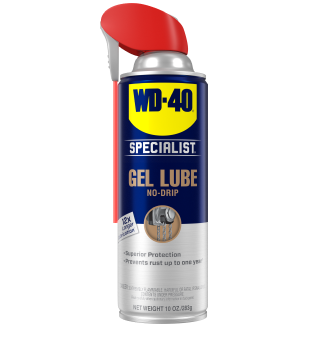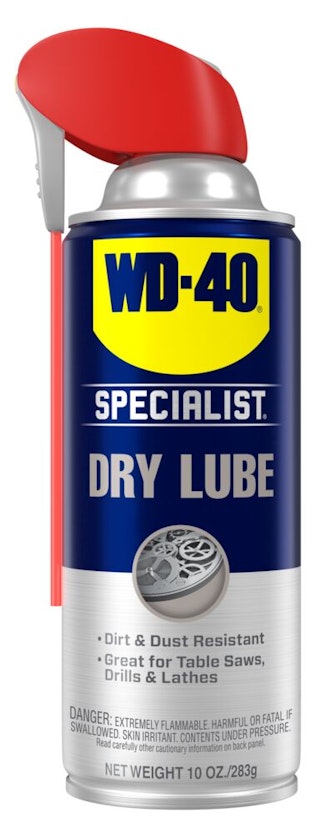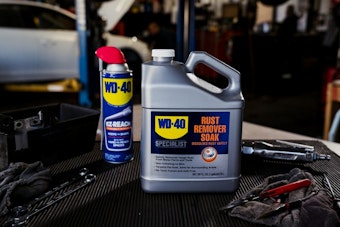The Longevity Factor: Exploring Long-Lasting Lubrication
The Longevity Factor: Exploring Long-Lasting Lubrication
<< Back“Time is a fickle friend; always and never on your side.” - Jonathan Dunne
Time is a perplexing force, often viewed as an adversary in the world of equipment performance. Time can exacerbate equipment causing wear and tear that leads to breakdowns and costly repairs. With the right preventative maintenance, time can be harnessed to extend the lifespan of equipment and reduce operating costs.
One of the best ways to harness the power of time and to ensure long-lasting equipment is through the use of a long-lasting lubricant like WD-40 Specialist® Gel Lube, a thick lubricant able to be used on vertical surfaces, and WD-40 Specialist® Dry Lube, a thin lubricant which forms a protective layer when lubricating equipment.
The Elements of Long-Lasting Lubrication
Long-lasting lubrication refers to lubricants that maintain their functional and protective properties over extended periods of time, even under severe conditions. This long-lasting protection is accredited to the lubricants’ resistant design. These formulations are characterized by chemical stability, higher viscosity and resistance to breakdown from temperatures, oxidation, shear stress and contamination.
Let's unpack these properties:
Chemical Stability and Resistance To Breakdown
Long-lasting lubricants possess an inherent resistance to chemical breakdown such as oxidation and hydrolysis. Because long-lasting lubricants maintain their properties like viscosity, thermal stability and oxidation resistance, their effectiveness stays stable even after prolonged exposure to harsh environments. As an example, the WD-40 Specialist Gel Lube is formulated to resist water and displace moisture. The WD-40 Specialist Dry Lube provides long-lasting lubrication and corrosion protection while repelling dirt, dust and oil.
Viscosity
Viscosity is the measure of the thickness of a fluid and its ability to flow. A high viscosity can be seen as syrup, thick and slow-flowing, while a low viscosity can be seen as water, thin and easy-flowing. Like Goldilocks you need to identify a viscosity that’s just right for your application; a lubricant that is too thin may not provide adequate protection, while one that is too thick may impede movement. A high viscosity lubricant like WD-40 Specialist Gel Lube is able to stick to surfaces providing long-lasting lubrication, while the lower viscosity of WD-40 Specialist Dry Lube allows it to get into hard-to-reach places and form a protective layer.
For more details, browse through our wide range of Specialist mechanical lubricants to find the right one for the job.
Types of Long-Lasting Lubricants
While there are many ways to categorize different types of industrial lubricants, the three we will be looking at in this article include synthetic lubricants, high-temperature lubricants, and advanced greases and oils. Below we provide an explanation for each, so that you are better equipped to make the correct choice for your intended application.
High-Temperature Lubricants
High-temperature lubricants, as the name suggests, are designed to perform in environments with extreme heat. These lubricants must be able to withstand high-temperatures while maintaining their lubrication and protective properties. WD-40 Specialist® Gel Lube, which lubricates and protects up to 500°F, is classified as a high-temperature lubricant and is effective in lubricating and protecting high-temperature equipment such as engine parts and industrial ovens.
Synthetic Lubricants
Synthetic lubricants are composed of oil components that have been manufactured synthetically. The synthesis of lubricants means that they can be specifically designed for novel applications like aerospace engineering and advanced robotics. They differ from oil-based lubricants which are refined petroleum crude oils or vegetable oils.
Advanced Greases and Oils
Advanced greases and oils refer to lubricants that have additives in the formulations. Within this context additives refer to chemical compounds like antioxidants, anti-wear agents and corrosion inhibitors. These additives enhance the performance of the lubricants by providing increased protection against wear and tear.
Looking for a long-lasting lubrication solution that is effective in a wide range of temperatures? We’ve got what you need.
Benefits of Long-Lasting Lubricants
Now that we better understand the various types of long-lasting lubricants available, the question becomes: what are the benefits of implementing them?
The chemical stability and viscosity of long-lasting lubricants have various benefits for both your equipment and your peace of mind. These benefits include reduced maintenance, conventional cost cuts and better-performing equipment.
Let’s explain in more detail.
Reduced Maintenance
Implementing long-lasting lubrication products into your maintenance routine will result in less time spent on upkeep and repairs. WD-40 Specialist® Gel Lube, lubricates 15x longer than the competition.* This means a staggering reduction of 1500% in maintenance frequency (and don’t forget the pesky downtime that goes along with it).
*Test Lab: Petro-Lubricant Laboratories Inc. (Lafayette, NJ); ASTM D5620A; Test date: 04/2020.
Cost Efficiency
The reduction in maintenance frequency inherently means your operation runs more cost efficiently. By minimizing maintenance frequency and downtime you are able to save on labor and part replacement costs, all while increasing the running time of your operation. Take for instance a conveyor belt, if you lubricate it with WD-40 Specialist Dry Lube you will reduce friction and wear in the long run, requiring less lubrication in the future. This reduction in lubricating monetizes in fewer man hours spent on maintenance, less expenses associated with purchasing parts and increased uptime of your equipment. In the simplest of terms, it’s a long-term savings investment.
Enhanced Performance
The increase in uptime of equipment is paramount in enhancing company efficiency. Using a long-lasting lubrication means that the percentage uptime (running time divided by total time elapsed) increases. But the efficiency gains do not stop with uptime; long-lasting lubrication allows better equipment performance and less energy usage of electrical apparatus like motors. An air compressor, for example, will experience less breakdowns and consume less energy when lubricated with a long-lasting lubricant like WD-40 Specialist Dry Lube.
Experience the benefits of long-lasting lubricants like WD-40 Specialist Dry Lube and WD-40 Specialist Gel Lube today.
Applications
The benefits of using long-lasting lubrication products extend to various industries, including industrial machinery engineering, automotive production as well the aerospace and defense business. The list of applicable industries really goes on and on (almost as long as WD-40 Specialist lubricants provide long-lasting lubrication).
Industrial Machinery
In heavy industries, like manufacturing and construction, long-lasting lubricants are of paramount importance. The machinery in these industries operate under heavy loads and harsh conditions, making effective lubrication essential in order to minimize wear and tear and prevent equipment failure.
Automotive Industry
In the automotive sphere, long-lasting lubrication is invaluable in maintaining engines’ performance, transmissions’ reliability and to loosen up sticky bearings on off-road and other vehicles.
See for yourself. Have a look at the uses of WD-40 Specialist® Gel Lube in off-road racing.
Aerospace and Defense
In the aerospace and defense sectors, long-lasting lubricants that are capable of withstanding extreme conditions like high temperatures and low pressures are particularly useful. Long-lasting lubricants provide reliable protection and performance against wear and corrosion, which ensures the safety of any passenger.
Selecting the Right Lubricant
Selecting the right lubricant may seem like a difficult task when looking at the wide range of options available. To simplify it for you, we will break down the three most critical factors to take into account when selecting a long-lasting lubrication solution:
Operating Temperature
Choose a lubricant that can withstand the operating temperatures of your machinery. High temperature stability is required in applications like engines, while low temperature stability is required in applications like refrigeration systems and cold storage equipment. Ensure to choose the right long-lasting lubricant for the temperature required. If you are unsure of what to choose, grab a can of WD-40 Specialist Dry Lube which lubricates between –50°F and 500°F.
Load
Ensure that the lubricant you choose can withstand the mechanical load experienced by your machinery parts without breaking down. The lubricant's primary function is to reduce the friction and wear experienced by these parts. High-load applications, like heavy-duty construction equipment and industrial presses, require lubricants with high film strength and exceptional load-carrying capacity to ensure the parts of the machinery don't experience high levels of wear. WD-40 Specialist® Dry Lube is designed to handle harsh conditions by maintaining a protective layer between moving parts, reducing wear and extending the life of your machinery.
Environmental Conditions
Ensure to select a long-lasting lubricant that is compatible with the environment it is to be used in. Take factors like moisture, dust and chemicals into account. For applications in marine environments, lubricants with water resistant properties (like WD-40 Specialist Silicone) are best suited.
If you need help choosing the right lubricant for your application, reach out to one of our experts.
Best Practices for Maximizing Lubricant Longevity
To maximize the longevity of your long-lasting lubricant, there are some practices we suggest you follow.
Proper Application:
Applying lubricants correctly is vital in ensuring their effectiveness. Be sure to follow the manufacturer’s recommendations to achieve the best results.
Regular Monitoring:
Regularly check the lubrication of your equipment to ensure you are not putting it at risk. Monitoring the equipment includes visual inspections like checking for degradation or contamination like dirt and rust. If you notice any degradation or contamination, it’s time to reapply.
Correct Storage:
Ensure to properly store your lubricants for the next time you use them. Keep your lubricants in cool and dry places and ensure to monitor their levels. You don't want to be caught in a “un-lubricated” situation.
Ensure you apply your long-lasting lubricant correctly! Have a look at our handy guide on how to Properly Spray Your WD-40® Brand Aerosol Product.
Look, we can’t do much about the flow of time, but we can do something about the effects time has on your equipment. Grab a can of WD-40 Specialist® Gel Lube, WD-40 Specialist® Dry Lube, and WD-40 Specialist® Silicone in a retailer near you to make time a less fickle friend.
FEATURED PRODUCTS
WANT TO GET MORE TIPS AND TRICKS?
SUBSCRIBE TO THE NEWSLETTER



